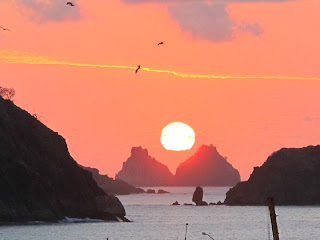Island of Fernando Norogna (Noronha)
Saturday, October 30, 2010
Mom Caught Me Looking At Feet
Photos by Michelle Costa Roque
The Archipelago was first described in 1503 by Amerigo Vespucci. It was invaded by French and Dutch, and finally, the Portuguese took possession. Several historical sites retain vestiges of the colonizers: Vila dos Remedios, Vila da Quixaba, Parque de Sant 'Ana, and the ruins of the fortifications St. Peter of Boldre, Santo Antonio, and Nossa Senhora da Conceição.
With 21 islands, Fernando de Noronha occupies a area of \u200b\u200b26 km ². The main island, the same name, is the only inhabited and is also the largest - 17 square miles. Part of the island is the National Marine Park of Fernando de Noronha, considered an Environmental Protection Area (APA) since 1988, with approximately 8 km ².
The park was created with the "objective of protecting the fauna, flora and other natural resources. The park includes all secondary islands. The "total extension of 112.7 km ², and the perimeter, 60 km. It has defined five paths that lead to places that can be visited with prior authorization of "IBAMA.
The population of "Arcipleago is approximately 2,100 people. Tourism is developed in a sustainable manner, creating the "opportunity of" meeting the balance between man and nature in one of the most important ecological sanctuaries in the world.
Fernando de Noronha has a good infrastructure to meet the tourist: bank branch, police station, post office, tourist information office, hospital, police, port, weather information, hotels, guesthouses and Internet access. In some of these small hotels, you deal directly with the locals, who transformed their homes into small hotels, guesthouses and lodges pleasant.
Flora The predominant vegetation in Fernando de Noronha is composed of species typical of the rural area of \u200b\u200bnorth-eastern Brazil, which lose their foliage in the dry season. In general, it has trees and shrubs in the higher areas on flat surfaces. From March to July, the vegetation is more exuberant, but greatly increases the chance of rain.
Fauna
Fernando de Noronha are many natural pools that allow direct contact with the varied and exotic local sea fauna. The waters of the islands are full of fish, sponges, algae, molluscs and corals, among which the most abundant of the "archipelago, Montastrea cavernosa.
From the viewpoint of the Baía dos Golfinhos (Bay of Dolphins), we see one of the finest performances ever imagined. Every day, at the "dawn, you can see groups of dolphins-rotator going to the" interior of the bay, an "area of" calm and protected, their natural environment.
You can also see turtles, from November, to groups on the surface of the water, the time when turtles turtles males compete for females, beginning the period of reproduction of the species . The National Center for Conservation and Management of Sea Turtles - better known as Project TAMAR / IBAMA - since 1984 takes care of female turtles, eggs and habitats of breeding e valuta la popolazione. Questi animali sono protetti da Decreto-Legge che proibisce la loro cattura, la pesca e il maltrattamento di tutte le specie di cheloni in acque brasiliane. L”arcipelago conta inoltre con specie endemiche, animali portati dall”uomo e animali migratori.
Subscribe to:
Post Comments (Atom)


0 comments:
Post a Comment